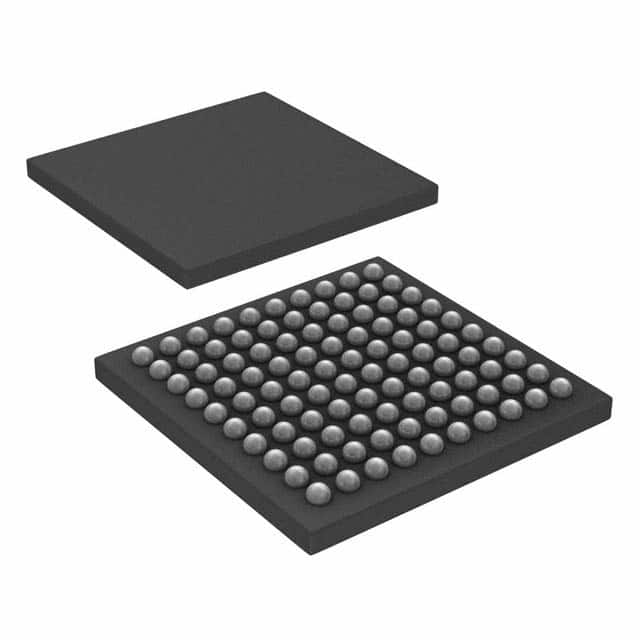AT91SAM7X256-CU
Product Overview
- Category: Microcontroller
- Use: Embedded systems development
- Characteristics:
- High-performance ARM7TDMI-S core
- 256KB Flash memory
- 64KB SRAM
- 55 general-purpose I/O lines
- 2 USARTs, SPI, and I2C interfaces
- USB 2.0 Full Speed Device
- 10-bit ADC with 8 channels
- 6 PWM channels
- Package: LQFP (Low-profile Quad Flat Package)
- Essence: A powerful microcontroller designed for embedded systems development.
- Packaging/Quantity: Available in tape and reel packaging, quantity varies based on customer requirements.
Specifications
- Core: ARM7TDMI-S
- Clock Speed: Up to 55 MHz
- Flash Memory: 256KB
- SRAM: 64KB
- I/O Lines: 55
- Interfaces:
- 2 x USART
- SPI
- I2C
- USB 2.0 Full Speed Device
- ADC: 10-bit, 8 channels
- PWM Channels: 6
Detailed Pin Configuration
The AT91SAM7X256-CU microcontroller has a total of 100 pins. The pin configuration is as follows:
- Pins 1-4: Ground (GND)
- Pins 5-8: Power Supply (VDD)
- Pins 9-12: Analog Ground (AGND)
- Pins 13-16: Analog Power Supply (AVDD)
- Pins 17-20: External Oscillator (XTAL)
- Pins 21-24: External Oscillator (XTAL)
- Pins 25-28: Reset (RESET)
- Pins 29-32: Power Supply (VDDCORE)
- Pins 33-36: Power Supply (VDDPLL)
- Pins 37-40: Power Supply (VDDUSB)
- Pins 41-44: USB Data Minus (DM)
- Pins 45-48: USB Data Plus (DP)
- Pins 49-52: USB Voltage Regulator Output (UVRO)
- Pins 53-56: USB Overcurrent Detection (UOD)
- Pins 57-60: USB Pull-up Control (UPCON)
- Pins 61-64: USB Transceiver Enable (UTE)
- Pins 65-68: USB ID (ID)
- Pins 69-72: USB Remote Wakeup (RWKUP)
- Pins 73-76: USB Connect (UCONN)
- Pins 77-80: USB Suspend (USUSP)
- Pins 81-84: USB Speed Indicator (USPEED)
- Pins 85-88: USB Clock (UCLOCK)
- Pins 89-92: USB Data Line (UDATA)
- Pins 93-96: USB Data Line (UDATA)
- Pins 97-100: Ground (GND)
Functional Features
The AT91SAM7X256-CU microcontroller offers several functional features, including:
- High-performance ARM7TDMI-S core for efficient processing.
- Ample Flash memory and SRAM for storing program code and data.
- Multiple communication interfaces such as USART, SPI, I2C, and USB for seamless connectivity.
- 10-bit ADC with 8 channels for analog signal acquisition.
- 6 PWM channels for precise control of output signals.
- Low-profile Quad Flat Package (LQFP) for easy integration into compact designs.
Advantages and Disadvantages
Advantages
- Powerful ARM7TDMI-S core for high-performance applications.
- Ample memory resources for storing program code and data.
- Versatile communication interfaces for seamless connectivity.
- Analog-to-digital converter for precise analog signal acquisition.
- PWM channels for accurate control of output signals.
- Compact package for easy integration into space-constrained designs.
Disadvantages
- Limited number of I/O lines compared to some other microcontrollers.
- Relatively higher power consumption compared to low-power microcontrollers.
- May require additional external components for certain applications.
Working Principles
The AT91SAM7X256-CU microcontroller operates based on the ARM7TDMI-S core architecture. It executes instructions fetched from the Flash memory and interacts with various peripherals through its communication interfaces. The microcontroller can be programmed using suitable development tools and software, allowing developers to create embedded systems tailored to specific requirements.
Detailed Application Field Plans
The AT91SAM7X256-CU microcontroller finds applications in various fields, including:
- Industrial automation: Control systems, motor drives, and PLCs.
- Consumer electronics
Lista 10 Vanliga frågor och svar relaterade till tillämpningen av AT91SAM7X256-CU i tekniska lösningar
Sure! Here are 10 common questions and answers related to the application of AT91SAM7X256-CU in technical solutions:
Q: What is the AT91SAM7X256-CU microcontroller used for? A: The AT91SAM7X256-CU is a microcontroller commonly used in embedded systems for various applications such as industrial automation, robotics, and IoT devices.
Q: What is the maximum clock frequency supported by the AT91SAM7X256-CU? A: The AT91SAM7X256-CU supports a maximum clock frequency of 55 MHz.
Q: How much flash memory does the AT91SAM7X256-CU have? A: The AT91SAM7X256-CU has 256 KB of flash memory for program storage.
Q: Can I expand the memory of the AT91SAM7X256-CU? A: Yes, the AT91SAM7X256-CU supports external memory expansion through its external bus interface.
Q: What peripherals are available on the AT91SAM7X256-CU? A: The AT91SAM7X256-CU includes various peripherals such as UART, SPI, I2C, ADC, PWM, and timers.
Q: Does the AT91SAM7X256-CU support USB connectivity? A: Yes, the AT91SAM7X256-CU features a USB 2.0 full-speed device port.
Q: Can I use the AT91SAM7X256-CU for real-time applications? A: Yes, the AT91SAM7X256-CU offers real-time performance with its integrated ARM7TDMI-S core and advanced interrupt controller.
Q: What development tools can I use with the AT91SAM7X256-CU? A: The AT91SAM7X256-CU is supported by various development tools, including Atmel Studio, Keil MDK, and GCC-based toolchains.
Q: Is the AT91SAM7X256-CU suitable for low-power applications? A: Yes, the AT91SAM7X256-CU features multiple power-saving modes and peripherals that enable efficient power management.
Q: Can I interface the AT91SAM7X256-CU with external sensors or actuators? A: Absolutely! The AT91SAM7X256-CU provides GPIO pins and various communication interfaces to connect and control external sensors and actuators.
Please note that these answers are general and may vary depending on specific implementation details and requirements.


